2018 MERCEDES-BENZ SLC ROADSTER warning
[x] Cancel search: warningPage 269 of 298
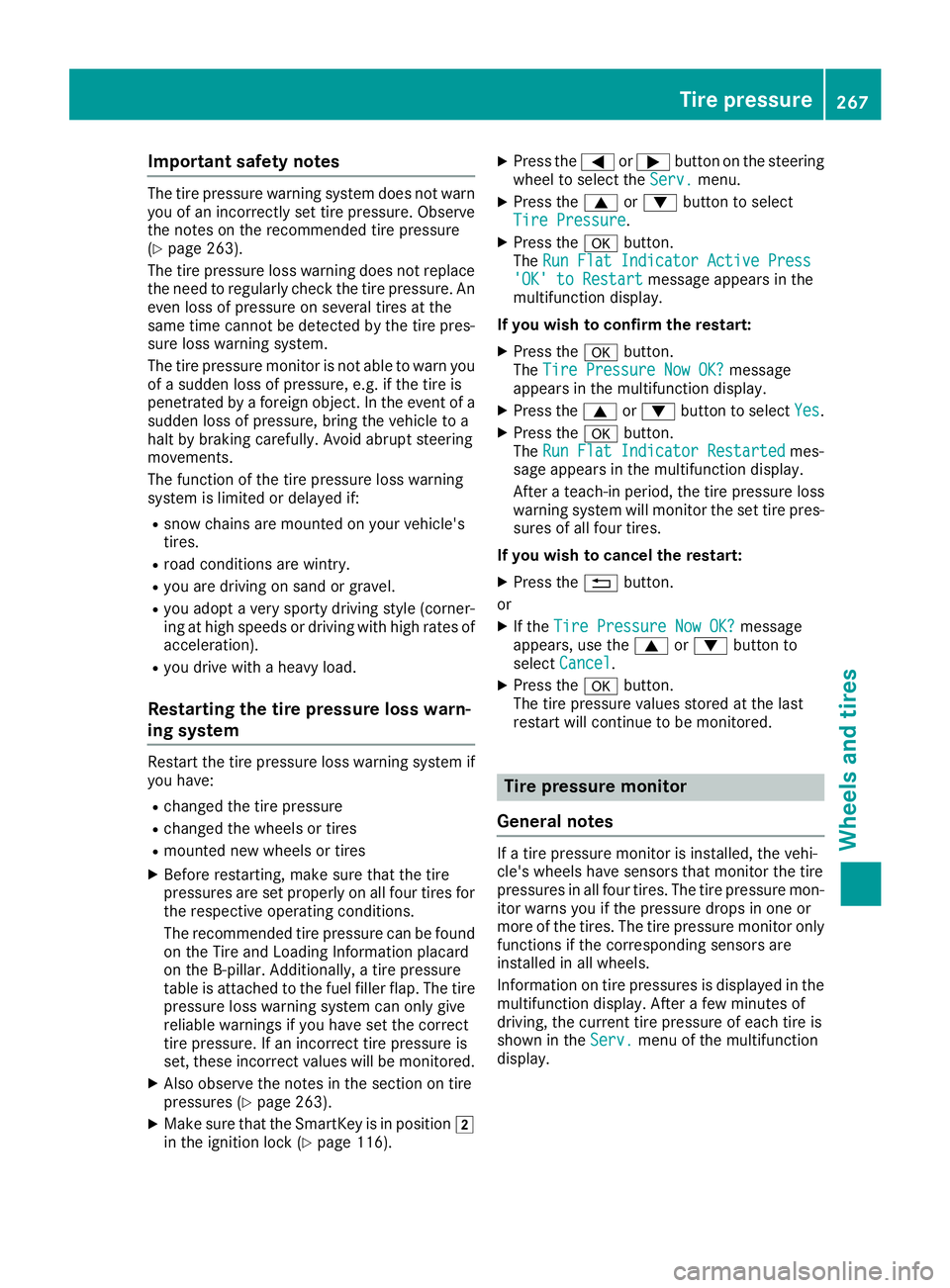
Important safety notes
The tire pressurewarning system does no twarn
you of an incorrectl yset tire pressure. Observ e
th en otes on th erecommended tire pressur e
(
Ypage 263).
The tire pressur eloss warning does no treplace
th en eedtor egularly chec kthe tire pressure. An
eve nloss of pressur eonseveral tires at th e
sam etimec anno tbed etecte dbythetire pres-
sur eloss warning system.
The tire pressur emonitor is no table to warn you
of as udde nloss of pressure, e.g. if th etirei s
penetrated by aforeign object. In th eevent of a
sudde nloss of pressure, brin gthe vehicl etoa
halt by braking carefully. Avoid abrup tsteering
movements.
The function of th etirep ressur eloss warning
system is limite dordelayedif:
Rsnow chain sare mounte donyour vehicle's
tires .
Rroad condition sare wintry.
Ryou are driving on san dorgravel.
Ryou adopt averys port ydriving style (corner-
ing at high speeds or driving wit hhigh rates of
acceleration).
Ryou driv ewithah eavyload.
Restarting th etirep ressure loss warn-
ing system
Restart th etirep ressur eloss warning system if
you have :
Rchanged th etirep ressur e
Rchanged th ewheels or tires
Rmounte dnew wheels or tires
XBefore restarting ,makes uret hatthe tire
pressures are set properly on all four tires for
th er espective operating conditions.
The recommended tire pressur ecan be foun d
on th eTirea nd Loading Information placard
on th eB-pillar .Additionally, atirep ressur e
table is attached to th efuel filler flap .The tire
pressur eloss warning system can only giv e
reliable warning sifyou have set th ecorrect
tire pressure. If an incorrec ttirep ressur eis
set ,the se incorrec tvalue swill be monitored.
XAlsoo bserv ethe note sint hesection on tire
pressures (Ypage 263).
XMakesuret ha tthe SmartKey is in position 2
in th eignition loc k(Ypage 116).
XPress the= or; buttononthesteering
whee ltos elect th eServ.menu.
XPress th e9 or: buttontos elect
Tir ePressure.
XPress th ea button.
The Run Fla tIndicator Active Press
'OK'toR estartmessage appear sinthe
multifunction display.
If you wish to confirm th erestart :
XPress th ea button.
The TirePressure Now OK?message
appear sinthemultifunction display.
XPress th e9 or: buttontos electYes.
XPress th ea button.
The Run Fla tIndicator Restartedmes -
sage appear sinthemultifunction display.
Afte rateach-in period, th etirep ressur eloss
warning system will monitor th eset tire pres-
sures of all four tires .
If you wish to cancel th erestart :
XPress th e% button.
or
XIf th eTir ePressure Now OK?message
appears, use th e9 or: buttonto
select Cancel
.
XPress th ea button.
The tire pressur evalue sstoredatt helast
restar twill continue to be monitored.
Tire pressure monitor
General notes
If at irep ressur emonitor is installed, th evehi-
cle's wheels hav esensor sthatm onitor th etire
pressures in all four tires .The tire pressur emon-
itor warn syou if th epressur edrops in on eor
mor eoft hetires .The tire pressur emonitor only
function sifthecorresponding sensor sare
installed in all wheels.
Information on tire pressures is displayed in th e
multifunction display. Afte rafew minute sof
driving ,the curren ttirep ressur eofeacht irei s
shown in th eServ.
men uoft hemultifunction
display.
Tire pressure267
Wheels and tires
Z
Page 270 of 298
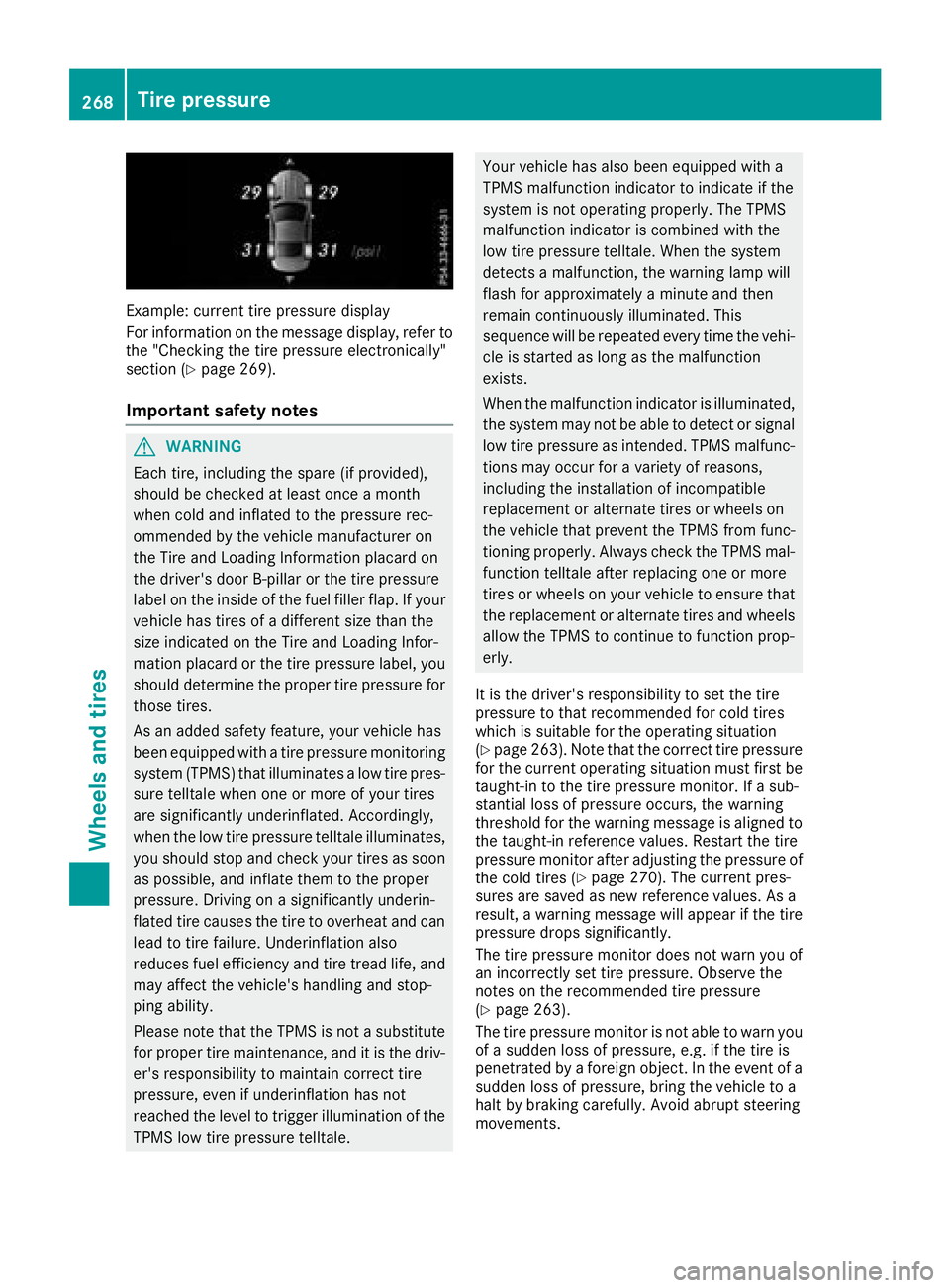
Example: current tire pressure display
For informationonthe message display, refer to
the "Checking the tire pressure electronically"
sectio n(
Ypage 269).
Important safety notes
GWARNING
Each tire ,including the spar e(ifprovided),
shoul dbec hecked at leas tonce amonth
when col dand inflate dtothe pressure rec-
ommended by the vehicl emanufacturer on
the Tire and Loading Informatio nplacard on
the driver's door B-pillar or the tire pressure
labe lont he insid eofthe fuel fille rflap. If your
vehicl ehastire sofad ifferent size thant he
size indicated on the Tire and Loading Infor-
matio nplacard or the tire pressure label, you
shoul ddetermine the prope rtire pressure for
thos etires.
As an adde dsafety feature, your vehicl ehas
been equipped with atire pressure monitoring
system (TPMS )thati llum inate salowtire pres-
sure telltale when one or mor eofyourtires
ar es ignificantl yunderinflated .Accordingly,
when the lo wtire pressure telltale illuminates,
yo us houl dstop and check your tire sassoon
as possible, and inflate themtot he proper
pressure. Driving on asignificantl yunderin-
flated tire causes the tire to overheat and can lead to tire failure. Underinflatio nalso
reduce sfue lefficiency and tire trea dlife, and
maya ffect the vehicle's handling and stop-
ping ability.
Please note thatt he TPMS is notasubst itute
for prope rt
ire ma
intenance ,and it is the driv-
er' sresponsibility to maintain correct tire
pressure, eve nifunderinflatio nhasnot
reachedt he level to triggeri llumination of the
TPMS lo wtire pressure telltale.
Your vehicl ehasalso been equipped with a
TPMS malfunctio nindicator to indicate if the
system is not operating properly .The TPMS
malfunctio nindicator is combine dwitht he
lo wt ire pressure telltale .Whent he system
detects amalfunction, the warning lamp will
flash for approximately aminute and then
remai ncontinuously illuminated. This
sequence will be repeated every time the vehi-
cle is started as long as the malfunction
exists.
When the malfunctio nindicator is illuminated,
the system mayn ot be able to detect or signal
lo wt ire pressure as intended. TPMS malfunc-
tions mayo ccurfor av ariety of reasons,
including the installatio nofincompatible
replacement or alternate tire sorwheelson
the vehicl ethatp revent the TPMS fromf unc-
tioning properly .Alway scheck the TPMS mal-
functio ntelltale after replacing one or more
tire sorw heelsony ourvehicl etoe nsurethat
the replacement or alternate tire sand wheels
allo wthe TPMS to continue to functio nprop-
erly.
It is the driver's responsibility to set the tire
pressure to thatr ecommendedfor col dtires
which is suitabl efor the operating situation
(
Ypage 263).N ote thatthe correct tire pressure
for the current operating situatio nmustfirst be
taught-i ntothe tire pressure monitor. If asub-
stantia llos sofp ressure occurs, the warning
threshold for the warning message is aligned to
the taught-i nreference values. Restart the tire
pressure monitor after adjusting the pressure of
the col dtires(
Ypage 270). The current pres-
sures ar esaved as new reference values. As a
result, awarning message will appear if the tire
pressure drops significantly.
The tire pressure monitor does not warn yo uof
an incorrectly set tire pressure. Observe the
note sont he recommende dtire pressure
(
Ypage 263).
The tire pressure monitor is not able to warn you
of as udde nlossofp ressure, e.g .ifthe tire is
penetrated by aforeign object. In the event of a
sudden loss of pressure, bring the vehicl etoa
halt by braking carefully. Avoi dabrup tsteering
movements.
268Tire pressure
Wheel sand tires
Page 271 of 298
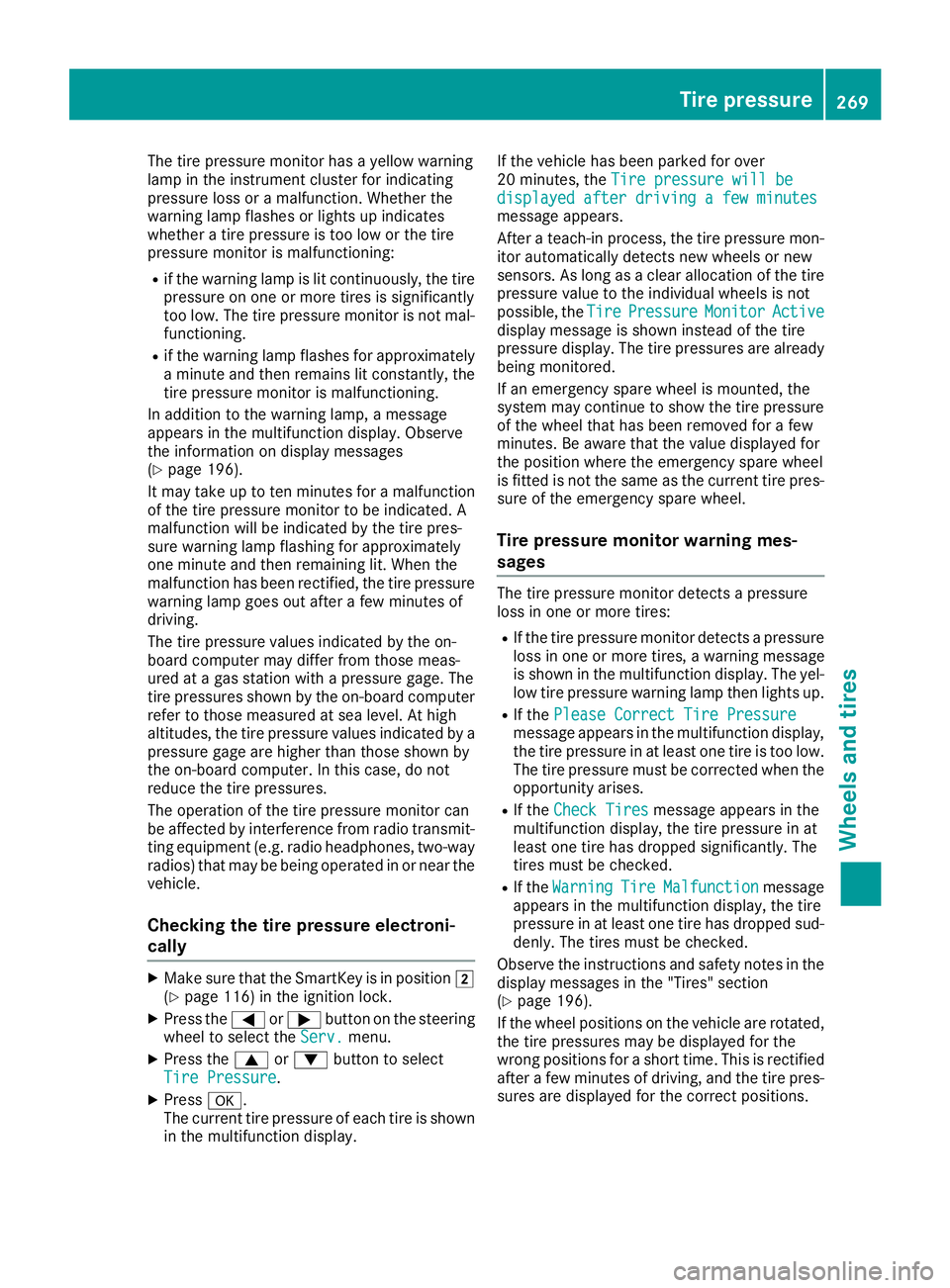
The tire pressure monitor hasayellow warning
lamp in the instrument cluster for indicating
pressure loss or amalfunction. Whether the
warning lamp flashes or lights up indicates
whether atire pressure is too low or the tire
pressure monitor is malfunctioning:
Rif the warning lamp is lit continuously, the tire
pressure on one or more tires is significantly
too low. The tire pressure monitor is not mal- functioning.
Rif the warning lamp flashes for approximately
am inute and then remains lit constantly, the
tire pressure monitor is malfunctioning.
In addition to the warning lamp, amessage
appears in the multifunction display.O bserve
the information on display messages
(
Ypage 196).
It may take up to ten minutes for amalfunction
of the tire pressure monitor to be indicated. A
malfunction will be indicated by the tire pres-
sure warning lamp flashing for approximately
one minute and then remaining lit. When the
malfunction has been rectified, the tire pressure
warning lamp goes out after afew minutes of
driving.
The tire pressure values indicated by the on-
board computer may differ from those meas-
ured at agas station with apressure gage. The
tire pressures shown by the on-board computer
refer to those measured at sea level. At high
altitudes, the tire pressure values indicated by a pressure gage are higher than those shown by
the on-board computer. In this case, do not
reduce the tire pressures.
The operation of the tire pressure monitor can
be affected by interferenc efrom radio transmit-
ting equipment (e.g. radio headphones, two-way
radios) that may be being operated in or near the vehicle.
Checking the tire pressur eelectroni-
cally
XMake sure that the SmartKey is in position 2
(Ypage 116) in the ignition lock.
XPress the =or; button on the steering
wheel to select the Serv.menu.
XPress the9or: button to select
Tire Pressure.
XPress a.
The current tire pressure of each tire is shown
in the multifunction display. If the vehicle has been parked for over
20 minutes, the
Tire pressure will be
displayed after driving afew minutesmessage appears.
After ateach-in process, the tire pressure mon-
itor automatically detect snew wheels or new
sensors. As long as aclear allocation of the tire
pressure value to the individual wheels is not
possible, the Tire
PressureMonitorActivedisplay message is shown instead of the tire
pressure display.T he tire pressures are already
being monitored.
If an emergencys pare wheel is mounted, the
system may continue to show the tire pressure
of the wheel that has been removed for afew
minutes. Be aware that the value displayed for
the position where the emergencys pare wheel
is fitted is not the same as the current tire pres-
sure of the emergencys pare wheel.
Tire pressuremonitor warning mes-
sages
The tire pressure monitor detect sapressure
loss in one or more tires:
RIf the tire pressure monitor detect sapressure
loss in one or more tires, awarning message
is shown in the multifunction display.T he yel-
low tire pressure warning lamp then lights up.
RIf the Please Correct Tire Pressuremessage appears in the multifunction display,
the tire pressure in at least one tire is too low.
The tire pressure must be corrected when the
opportunit yarises.
RIf the Check Tiresmessage appears in the
multifunction display,t he tire pressure in at
least one tire has dropped significantly. The
tires must be checked.
RIf the WarningTireMalfunctionmessage
appears in the multifunction display,t he tire
pressure in at least one tire has dropped sud-
denly. The tires must be checked.
Observe the instructions and safety notes in the
display messages in the "Tires" section
(
Ypage 196).
If the wheel positions on the vehicle are rotated,
the tire pressures may be displayed for the
wrong positions for ashort time. This is rectified
after afew minutes of driving, and the tire pres-
sures are displayed for the correctp ositions.
Tirepressure269
Wheels and tires
Z
Page 272 of 298
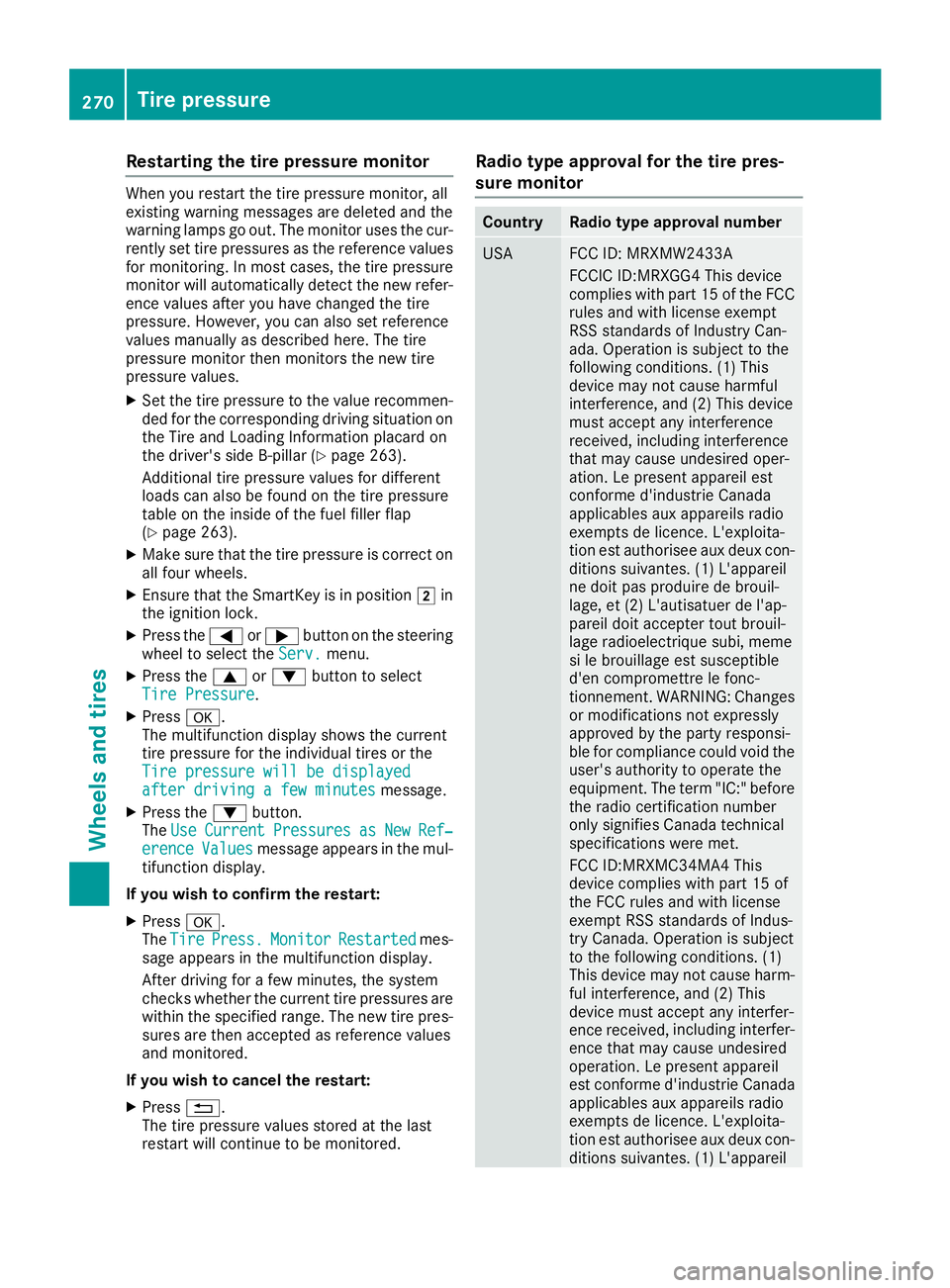
Restarting the tire pressure monitor
Whenyourestart the tire pressure monitor, all
existing warning messages are deleted and the
warning lamps go out. The monitor uses the cur-
rentlys et tire pressures as the reference values
for monitoring. In most cases, the tire pressure
monitor will automaticall ydetect the new refer-
ence value safteryou have changed the tire
pressure. However, yo ucan also set reference
value smanually as described here. The tire
pressure monitor then monitors the new tire
pressure values.
XSet the tire pressure to the value recommen-
ded for the corresponding driving situation on
the Tire and Loading Information placard on
the driver'ss ideB -pillar (
Ypage 263).
Additiona ltire pressure value sfor different
load scan also be found on the tire pressure
table on the inside of the fue lfille rflap
(
Ypage 263).
XMake sure that the tire pressure is correct on
al lf ourw heels.
XEnsur ethat the SmartKey is in position 2in
the ignition lock.
XPress the =or; button on the steering
wheel to select the Serv.menu.
XPress the9or: button to select
Tire Pressure.
XPress a.
The multifunction display shows the current
tire pressure for the individual tire sorthe
Tire pressure will be displayed
afterd rivingafew minutesmessage.
XPress the :button.
The UseCurrentPressuresasNewRef‐erenceValuesmessage appears in the mul-
tifunction display.
If you wish to confirm the restart:
XPress a.
The TirePress.MonitorRestartedmes-
sage appears in the multifunction display.
After driving for afew minutes, the system
checks whethert he current tire pressures are
within the specified range. The new tire pres-
sures are then accepted as reference values
and monitored.
If you wish to cance lthe restart:
XPress %.
The tire pressure value sstoredatt he last
restart will continu etobemonitored.
Radio type approval for the tire pres-
sure monitor
CountryRadio type approval number
USAFCC ID: MRXMW2433A
FCCIC ID:MRXGG4 Thisd evice
complies with part 15 of the FCC
rules and with license exempt
RSS standard sofIndustry Can-
ada. Operation is subject to the
following conditions .(1) This
device may not cause harmful
interference, and (2) Thisd evice
mus taccept any interference
received, including interference
that may cause undesired oper-
ation. Le present appareile st
conforme d'industrieC anada
applicables au xappar eils radio
exempts de licence. L'exploita-
tion est authorisee au xdeuxc on-
ditions suivantes. (1) L'appareil
ne doi tpas produire de brouil-
lage, et (2) L'autisatue rdel'ap-
pareild oita ccepter toutb rouil-
lage radioelectriqu esubi, meme
si le brouillag eest susceptible
d'e ncompromettre le fonc-
tionnement. WARNING:C hanges
or modifications not expressly
approved by the party responsi-
bl ef or compliance could voidt he
user'sa uthority to operate the
equipment. The term "IC:" before the radio certification number
only signifies Canad atechnical
specifications were met.
FCC ID:MRXMC34MA4 This
device complies with part 15 of
the FCC rules and with license
exempt RSS standard sofIndus-
try Canada. Operation is subject
to the following conditions .(1)
Thisd evice may not cause harm-
ful interference, and (2) This
device mus taccept any interfer-
ence received, inclu
ding interfer-
ence that may cause undesired
operation. Le present appareil
est conforme d'industrieC anada
applicables au xappar eils radio
exempts de licence. L'exploita-
tion est authorisee au xdeuxc on-
ditions suivantes. (1) L'appareil
270Tire pressure
Wheel sand tires
Page 273 of 298
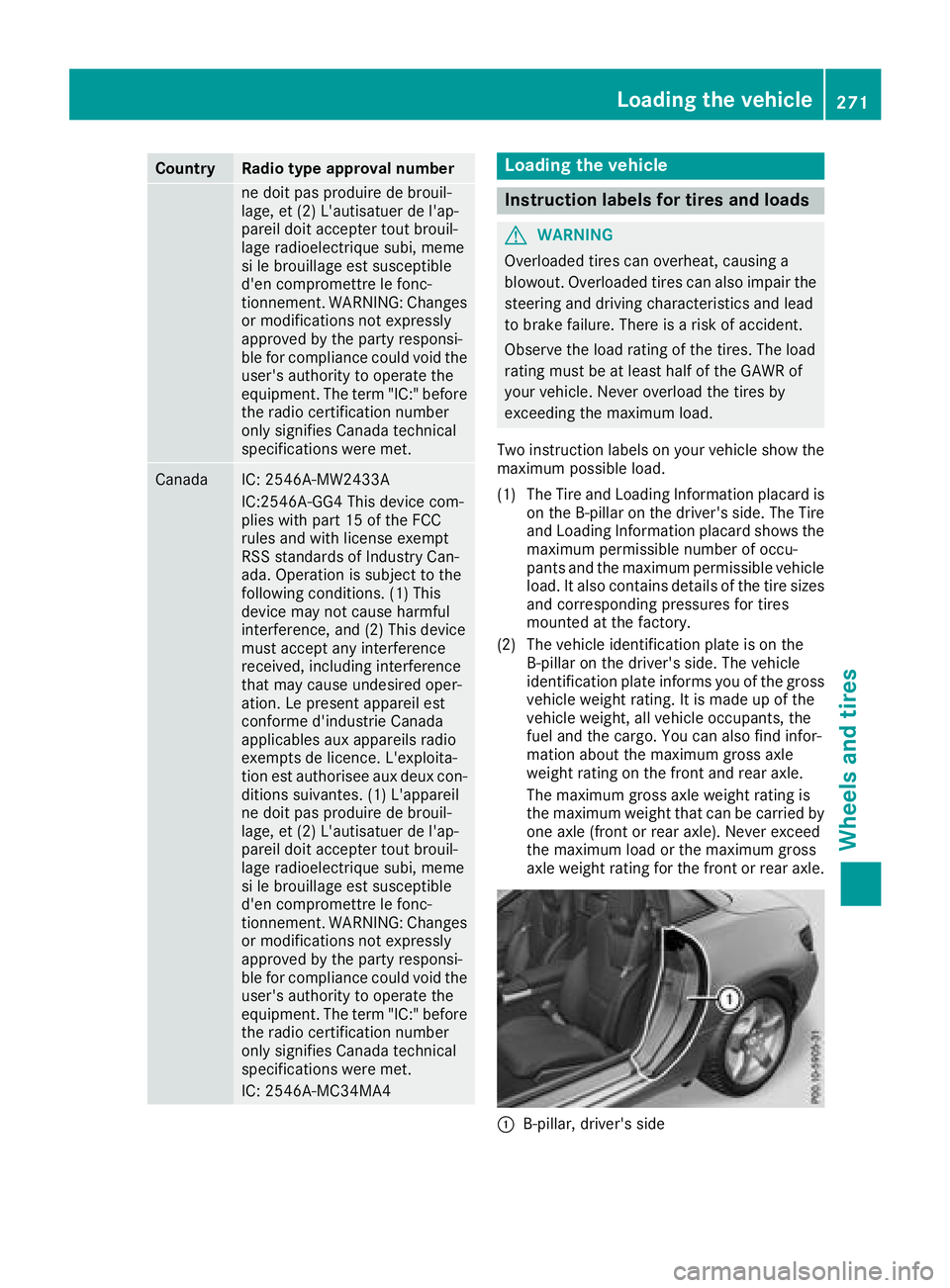
CountryRadio type approval number
ne doit pas produire de brouil-
lage, et (2) L'autisatuer de l'ap-
pareil doit accepter tout brouil-
lage radioelectrique subi, meme
si le brouillage est susceptible
d'en compromettre le fonc-
tionnement. WARNING: Changes
or modifications not expressly
approved by thepartyr esponsi-
ble for compliance could void the
user'sa uthorityt ooperate the
equipment .The ter m"IC:"b efore
th er adio certification number
onl ysignifies Canada technical
specifications were met.
CanadaIC: 2546A-MW2433A
IC:2546A-GG4 This devic ecom-
plies with part 15 of th eFCC
rules and with licens eexempt
RSS standards of Industry Can-
ada. Operatio nissubject to the
following conditions. (1) This
devic emay not cause harmful
interference, and (2) This device
must accept any interference
received ,includingi nterference
that may cause undesiredo per-
ation. Le present appareil est
conforme d'industrie Canada
applicables aux appareils radio
exemptsdel icence. L'exploita-
tio ne st authorisee aux deux con-
ditionss uivantes.(1) L'appareil
ne doit pas produire de brouil-
lage, et (2) L'autisatuer de l'ap-
pareil doit accepter tout brouil-
lage radioelectrique subi, meme
si le brouillage est susceptible
d'en compromettre le fonc-
tionnement. WARNING: Changes
or modifications not expressly
approved by th epartyr esponsi-
ble for compliance could void the
user'sa uthorityt ooperate the
equipment .The ter m"IC:"b efore
th er adio certification number
onl ysignifies Canada technical
specifications were met.
IC: 2546A-MC34MA4
Loading th evehicle
Instruction labels for tires and loads
GWARNING
Overloadedt ires can overheat,c ausing a
blowout.O verloadedt ires can also impair the
steeringa nd driving characteristic sand lead
to brakef ailure. Thereisar isk of accident.
Observe th eload rating of th etires. The load
rating must be at least half of th eGAWR of
your vehicle .Never overload th etires by
exceedingt hemaximum load.
Two instruction labels on your vehicle show the maximum possible load.
(1) The Tire and LoadingI nformation placar dis
on th eB-pillar on th edriver' sside. The Tire
and LoadingI nformation placar dshows the
maximum permissible number of occu-
pant sand th emaximum permissible vehicle
load. It also contain sdetails of th etires izes
and corresponding pressures for tires
mounted at th efactory.
(2) The vehicle identification plateisont he
B-pillar on th edriver' sside. The vehicle
identification platei nformsyou of thegross
vehicle weight rating .Itismade up of the
vehicle weight,a ll vehicle occupants, the
fuel and th ecargo. You can also fin dinfor-
mation about th emaximum gross axle
weight rating on th efront and rear axle.
The maximum gross axle weight rating is
th em aximum weight that can be carried by
one axle (front or rear axle) .Never exceed
th em aximum load or th emaximum gross
axle weight rating for th efront or rear axle.
:B-pillar ,driver' sside
Loading th evehicle271
Wheels and tires
Z
Page 276 of 298
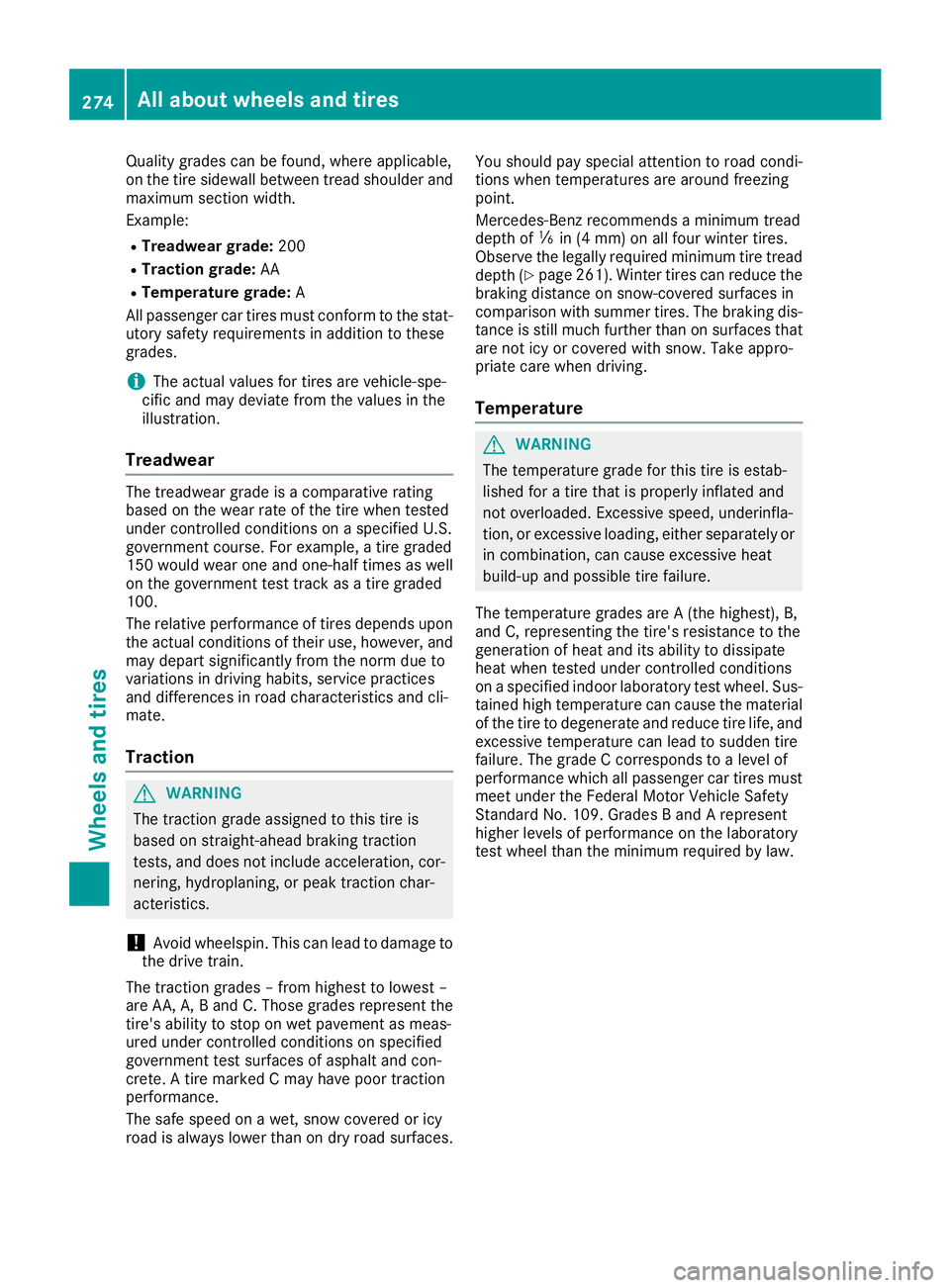
Quality grades can be found,where applicable,
on the tire sidewall between tread shoulde rand
maximum sectio nwidth.
Example:
RTreadwear grade: 200
RTractiongrade: AA
RTemperature grade: A
All passengerc ar tires must conform to the stat-
utory safety requirements in additio ntothese
grades.
iThe actua lvalues for tires are vehicle-spe-
cific and may deviate from the values in the
illustration.
Treadwear
The treadwea rgrad eisac omparativ erating
based on the wea rrate of the tire whe ntested
unde rcontrolled conditions on aspecified U.S.
government course. For example, atire graded
150 would wea rone and one-half times as well
on the government test track as atire graded
100.
The relative performance of tires depends upon
the actua lconditions of their use ,however, and
may depart significantly from the norm duet o
variations in driving habits, service practices
and differences in road characteristics and cli-
mate.
Traction
GWARNING
The tractio ngrad eassignedtot his tire is
based on straight-ahead braking traction
tests, and doesn ot include acceleration, cor-
nering, hydroplaning ,orpeaktractio nchar-
acteristics.
!Avoid wheelspin. Thisc an leadtodamage to
the driv etrain.
The tractio ngrades –from highest to lowest –
are AA, A, Band C. Thoseg rades represent the
tire's ability to stop on wet pavement as meas-
ure dunde rcontrolled conditions on specified
government test surfaces of asphal tand con-
crete. Atire marked Cmay have poort raction
performance.
The safe speedonaw et, snow coveredoricy
road is always lower than on dry road surfaces. You should pay speciala
ttentiontoroadc ondi-
tions whe ntemperatures are around freezing
point.
Mercedes-Benz recommends aminimum tread
depth of ãin (4 mm )onallfour winter tires.
Observe the legally required minimum tire tread
depth (
Ypag e261). Winter tires can reduce the
braking distance on snow-covered surfaces in
comparisonw iths ummer tires. The braking dis-
tance is stil lmuch furthe rthan on surfaces that
are not icy or coveredw iths now. Take appro-
priate care whe ndriving.
Temperature
GWARNING
The temperature grad efor this tire is estab-
lished for atire that is properly inflated and
not overloaded. Excessiv espeed, underinfla-
tion, or excessive loading ,eithers eparately or
in combination, can cause excessive heat
build-up and possibl etire failure.
The temperature grades are A(the highest),B ,
and C, representing the tire's resistance to the
generation of heata nd its ability to dissipate
heatw hent ested unde rcontrolled conditions
on aspecified indoor laboratory test wheel. Sus-
taine dhight emperature can cause the material
of the tire to degenerate and reduce tire life, and
excessive temperature can leadtos udden tire
failure. The grad eCcorresponds to aleve lof
performance which al lpassengerc ar tires must
meet unde rthe Federal Motor Vehicle Safety
Standard No. 109. Grades BandArepresent
higher levels of performance on the laboratory
test wheel than the minimum required by law.
274Al la bout wheelsa nd tires
Wheels and tires
Page 277 of 298
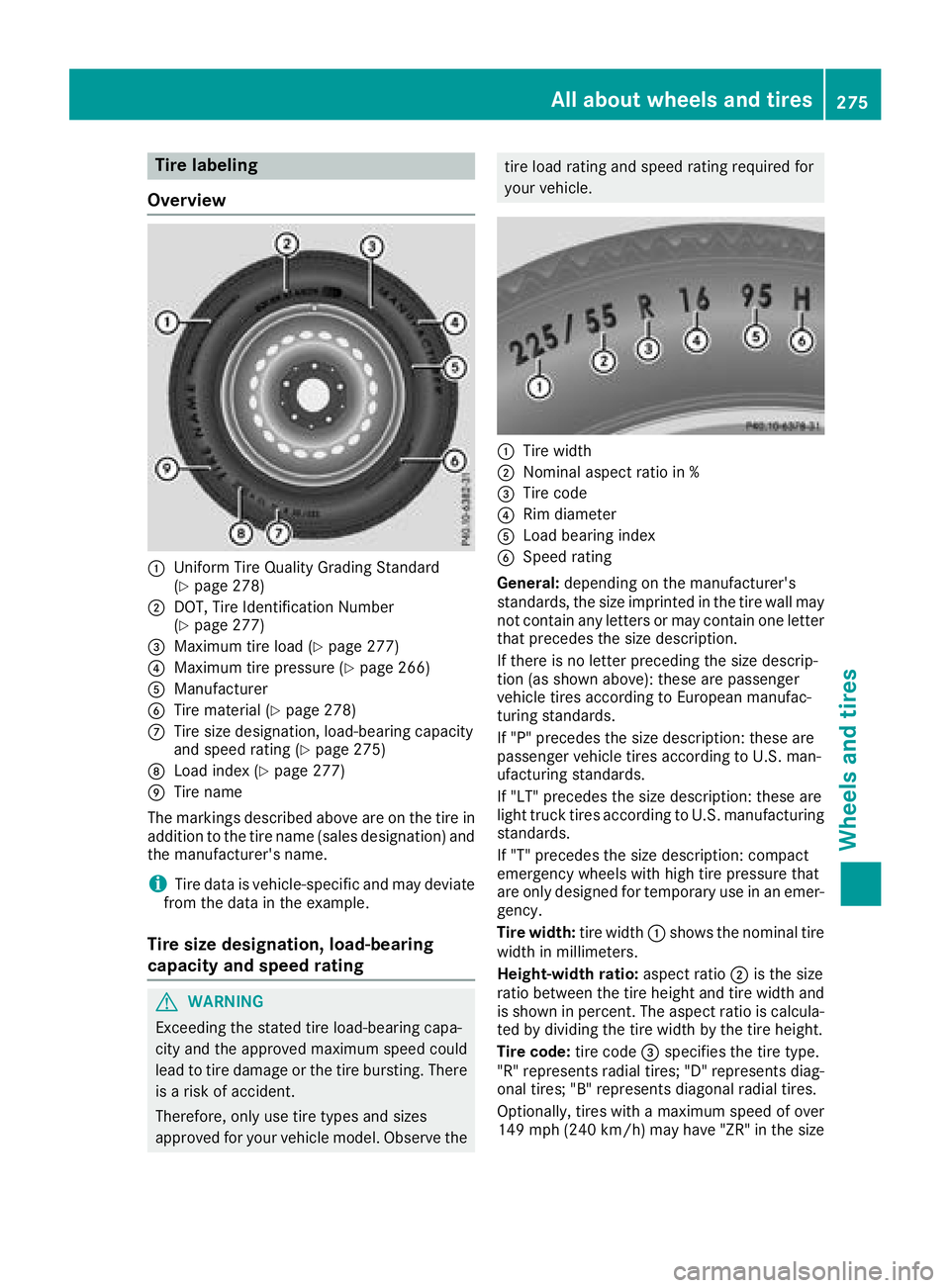
Tire labeling
Overview
:Unifor mTireQ ualit yGradin gStandard
(Ypage 278)
;DOT, Tire Identification Number
(Ypage 277)
=Maximum tire load (Ypage 277)
?Maximum tire pressure (Ypage 266)
AManufacturer
BTire material (Ypage 278)
CTire size designation, load-bearing capacity
and spee drating (Ypage 275)
DLoadi ndex (Ypage 277)
ETire name
The markings describe dabove ar eont he tire in
additio ntothe tire nam e(sales designation) and
the manufacturer's name.
iTire data is vehicle-specific and mayd eviate
fromt he data in the example.
Tire size designation ,loa d-bearing
capacity and speed rating
GWARNING
Exceeding the stated tire load-bearing capa-
city and the approved maximum spee dcould
lead to tire damage or the tire bursting. There is ar iskofa ccident.
Therefore ,onlyu setire types and sizes
approved for your vehicl emodel .Observe the
tire load rating and spee drating required for
your vehicle.
:Tire width
;Nomina laspec tratio in %
=Tire code
?Rimd iame ter
ALoadb earing index
BSpeed rating
General: depending on the manufacturer's
standards ,the size imprinted in the tire wall may
not contain any letters or mayc ontain one letter
thatp recedes the size description.
If there is no letter preceding the size descrip-
tio n(as shown above): these ar epassenger
vehicl etiresa ccording to Europea nmanufac-
turing standards.
If "P "precedes the size description: these are
passenge rvehicl etiresa ccording to U.S. man-
ufacturin gstandards.
If "LT" precedes the size description: these are
light truck tire saccording to U.S. manufacturing
standards.
If "T "precedes the size description: compact
emergency wheels with high tire pressure that
ar eo nlyd esig nedf or temporary us einanemer-
gency.
Tire width: tire width:shows the nominal tire
width in millimeters.
Height-width ratio: aspect ratio;is the size
ratio between the tire height and tire width and
is shown in percent. The aspect ratio is calcula-
ted by dividing the tire width by the tire height.
Tire code: tire code=specifie sthe tire type.
"R "r epresents radial tires; "D" represents diag-
ona ltire s; "
B" represents diagona
lradial tires.
Optionally ,tire sw itham aximum spee dofover
149 mph (24 0km/h )mayhave "ZR" in the size
Alla bout wheels an dtires275
Wheel sand tires
Z
Page 282 of 298
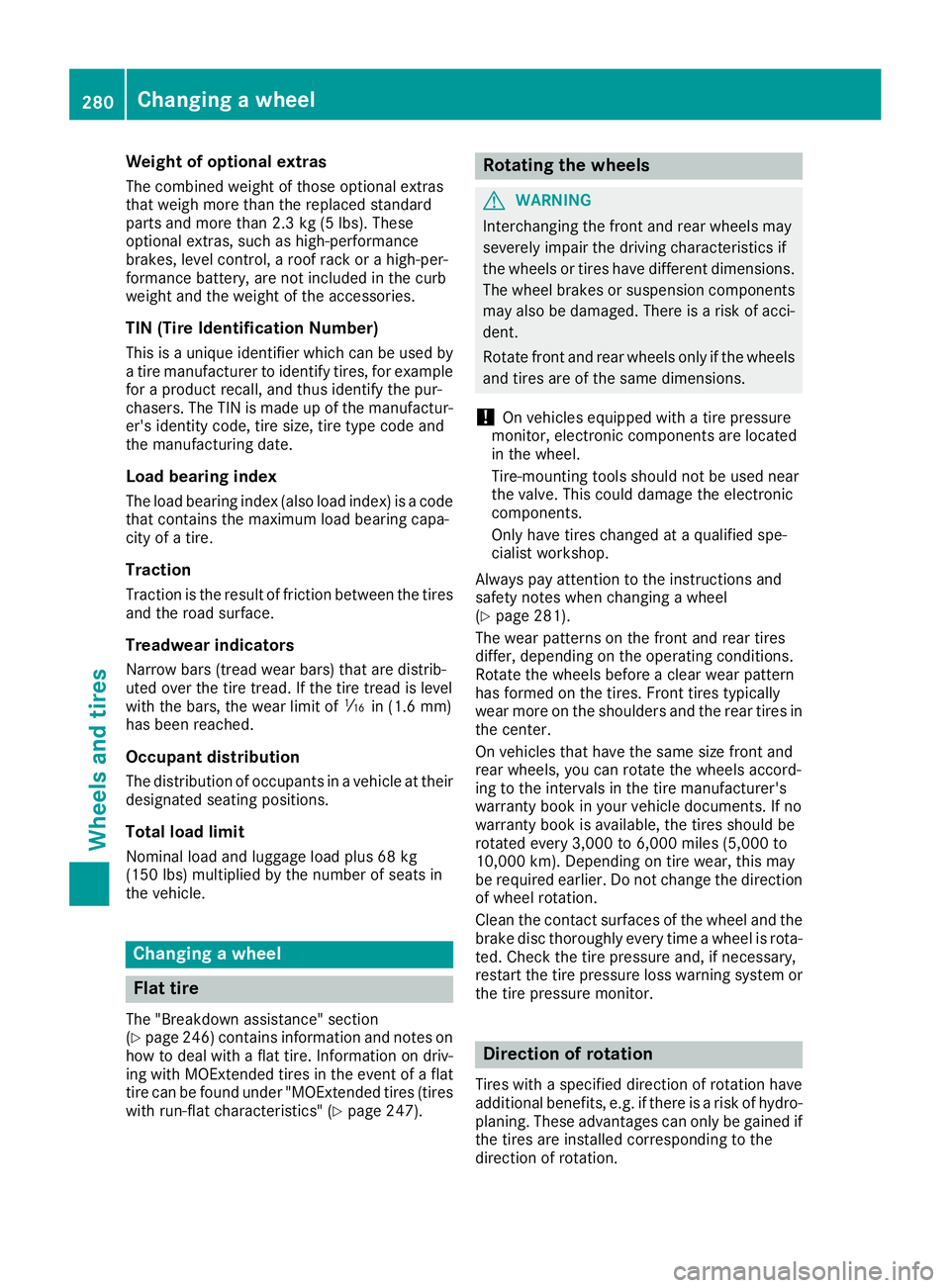
Weight of optional extras
The combined weight of those optionalextras
that weigh more than the replaced standard
parts and more than 2.3 kg (5 lbs).T hese
optionale xtras, such as high-performance
brakes ,levelc ontrol, aroof rack or ahigh-per-
formance battery,a re not included in the curb
weight and the weight of the accessories.
TIN (Tire Identification Number)
This is aunique identifier which can be use dby
at ire manufacturer to identify tires, for example
for aproduct recall, and thus identify the pur-
chasers. The TIN is made up of the manufactur-
er's identity code, tire size, tire type code and
the manufacturing date.
Load bearin gindex
The loadb earing index (also loadi ndex) isacode
that contains the maximu mloadb earing capa-
city of atire.
Traction
Tractio nisthe result of friction between the tires
and the road surface.
Treadwear indicators
Narrow bars (tread wearb ars)that are distrib-
uted over the tire tread. If the tire tread is level
with the bars ,the wearl imitofá in (1.6 mm)
has been reached.
Occupant distribution
The distribution of occupants in avehicleatt heir
designated seating positions.
Total load limit
Nominall oadand luggagel oadplus68kg
(150 lbs) multiplied by the number of seats in
the vehicle.
Changing awheel
Flat tire
The "Breakdown assistance" section
(Ypage2 46) contains information and notes on
how to dealw ithaflat tire. Informatio nondriv-
ing with MOExtended tires in the event of aflat
tire can be found under "MOExtended tires (tires
with run-fla tcharacteristics" (
Ypage2 47).
Rotating the wheels
GWARNING
Interchanging the front and rear wheels may
severely impair the driving characteristics if
the wheels or tires have different dimensions. The wheelb rakes or suspension components
may als obedamaged. There is arisk of acci-
dent.
Rotate front and rear wheels only if the wheels and tires are of the same dimensions.
!On vehicles equipped with atire pressure
monitor, electronic components are located
in the wheel.
Tire-mounting tools should not be use dnear
the valve .This coul ddamage the electronic
components.
Only have tires changed at aqualified spe-
cialist workshop.
Always pay attention to the instructions and
safety notes when changing awheel
(
Ypage2 81).
The wearp atterns on the front and rear tires
differ, depending on the operating conditions.
Rotate the wheels before aclearw earp attern
has formed on the tires. Front tires typically
wearm ore on the shoulders and the rear tires in
the center.
On vehicles that have the same size front and
rear wheels, you can rotate the wheels accord-
ing to the interval sinthe tire manufacturer's
warranty book in you rvehicled ocuments. If no
warranty book is available,t he tires should be
rotated every 3,000 to 6,000 mile s(5,000 to
10,000 km) .Depending on tire wear, this may
be required earlier. Do not change the direction
of wheelr otation.
Clean the contact surfaces of the wheela nd the
brake disc thoroughly every time awhee lisr ota-
ted. Check the tire pressure and, if necessary,
restart the tire pressure loss warning system or
the tire pressure monitor.
Directio nofrotation
Tires with aspecified direction of rotation have
additionalb enefits, e.g. if there is arisk of hydro-
planing. These advantages can only be gained if
the tires are installed corresponding to the
direction of rotation.
280Changing awheel
Wheels and tires